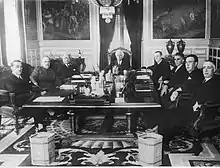Party of the Democratic Centre Partido del Centro Democrático | |
|---|---|
| Leader | Manuel Portela Valladares |
| Founded | January 28, 1936 |
| Dissolved | April 1, 1939[lower-alpha 1] |
| Split from | Radical Republican Party |
| Ideology | Republicanism Centrism Anticommunism |
| Political position | Centre |
| Congress of Deputies (1936) | 18 / 473 |
| |
The Party of the Democratic Centre (Spanish: Partido del Centro Democrático, PCD) was a centrist political party active in the Second Spanish Republic.
History
The origins of the PCD can be traced back to a note issued to the press on 31 December 1935. The note attempted to justify the previous day's cabinet reshuffle, carried out by Prime Minister Manuel Portela Valladares with the support of President Niceto Alcalá-Zamora, by describing it as 'a necessary effort to create a Republican center'.[2] A number of those appointed to Portela's new cabinet would go on to join the PCD.[3][4][5] The party's manifesto, published on January 28, 1936, 'rejected both "civil war" and "red revolution"' whilst 'stressing constitutional process, national unity and progress.'.[6]

In the run-up to the 1936 Spanish general elections, Portela and the PCD initially tried to forge an alliance with the political left.[7] Portela's offer was 'roundly rejected' in all provinces but Lugo and Alicante, and he instead turned to the political right.[8] In total 89 PCD candidates stood for election in 1936.[9] However, by the time the elections took place this number had fallen to 78 - the result of numerous defections; with only 23 securing places on 'broader center-right coalition tickets'.[10] The PCD's failure to make a breakthrough in the 1936 elections has been attributed to both Portela's attempt to try and rapidly build a new party ex nihilo in a period of increased radicalisation,[11] and his failure to build the strong alliance with either the left or the right that he deemed necessary.[12][13]
The PCD initially won 21 seats in the 1936 elections.[14] This total later fell to 18[15] when elections in Cuenca and Granada were re-held in an attempt to mitigate the impact of acts of electoral fraud carried out by the political right.[16][17] It has been alleged that Alcalá-Zamora pressured the comisión de actas, the committee for examining electoral validity, into approving the election of Portela in Pontevedra despite the existence of evidence of electoral malpractice in the city.[18] The PCD's participation in government came to an end with the resignation of a 'terror-stricken'[19][20] Portela on 19 February 1936.
5 members of the PCD were the only deputies to vote against the removal of Alcalá-Zamora as President of the Republic.[21]
References
- ↑ Cabanellas Ferrer, Miguel (1936). [Decree No. 108 of the Junta of National Defense] (in Spanish) – via Wikisource.
- ↑ Payne, Stanley G. (2017). Alcalá Zamora and the Failure of the Spanish Republic, 1931–1936. Eastbourne, East Sussex: Sussex Academic Press. p. 116. ISBN 978-1-78284-399-3.
- ↑ "BECERRA FERNANDEZ, MANUEL". Congreso de los Diputados. Congreso de los Diputados. Archived from the original on 15 December 2019. Retrieved 15 December 2019.
- ↑ "VILLALOBOS GONZALEZ, FILIBERTO". Congreso de los Diputados. Congreso de los Diputados. Archived from the original on 15 December 2019. Retrieved 15 December 2019.
- ↑ "RICO AVELLO, MANUEL". Congreso de los Diputados. Congreso de los Diputados. Archived from the original on 16 December 2019. Retrieved 16 December 2019.
- ↑ Payne, Stanley G. (2006). The Collapse of the Spanish Republic, 1933–1936. New Haven, Connecticut: Yale University Press. p. 171. ISBN 0-300-11065-0.
- ↑ Payne, Stanley G. (2017). Alcalá Zamora and the Failure of the Spanish Republic, 1931–1936. Eastbourne, East Sussex: Sussex Academic Press. p. 120. ISBN 978-1-78284-399-3.
- ↑ Preston, Paul (1978). The Coming of the Spanish Civil War: Reform, Reaction and Revolution in the Second Republic 1931-1936. London and Basingstoke: The Macmillan Press. p. 170. ISBN 978-1-349-03758-2.
- ↑ "RESUMEN DE CANDIDATOS PROCLAMADOS" [Summary of Candidates Announced]. ABC (in Spanish). Madrid. 2 February 1936. Retrieved 21 November 2019.
- ↑ Payne, Stanley G. (2006). The Collapse of the Spanish Republic, 1933–1936. New Haven, Connecticut: Yale University Press. pp. 171–172. ISBN 0-300-11065-0.
- ↑ Payne, Stanley G. (2006). The Collapse of the Spanish Republic, 1933–1936. New Haven, Connecticut: Yale University Press. p. 170. ISBN 0-300-11065-0.
- ↑ Preston, Paul (1978). The Coming of the Spanish Civil War: Reform, Reaction and Revolution in the Second Republic 1931-1936. London and Basingstoke: The Macmillan Press. p. 170. ISBN 978-1-349-03758-2.
- ↑ Jackson, Gabriel (1965). The Spanish Republic and the Civil War 1931-1939. Princeton, New Jersey: Princeton University Press. p. 189. ISBN 978-0-691-00757-1.
- ↑ Payne, Stanley G. (2006). The Collapse of the Spanish Republic, 1933–1936. New Haven, Connecticut: Yale University Press. p. 177. ISBN 0-300-11065-0.
- ↑ Preston, Paul (1978). The Coming of the Spanish Civil War: Reform, Reaction and Revolution in the Second Republic 1931-1936. London and Basingstoke: The Macmillan Press. p. 231. ISBN 978-1-349-03758-2.
- ↑ Preston, Paul (1978). The Coming of the Spanish Civil War: Reform, Reaction and Revolution in the Second Republic 1931-1936. London and Basingstoke: The Macmillan Press. p. 183. ISBN 978-1-349-03758-2.
- ↑ Jackson, Gabriel (1965). The Spanish Republic and the Civil War 1931-1939. Princeton, New Jersey: Princeton University Press. p. 205. ISBN 978-0-691-00757-1.
- ↑ Preston, Paul (1978). The Coming of the Spanish Civil War: Reform, Reaction and Revolution in the Second Republic 1931-1936. London and Basingstoke: The Macmillan Press. p. 183. ISBN 978-1-349-03758-2.
- ↑ Jackson, Gabriel (1965). The Spanish Republic and the Civil War 1931-1939. Princeton, New Jersey: Princeton University Press. p. 195. ISBN 978-0-691-00757-1.
- ↑ Preston, Paul (1978). The Coming of the Spanish Civil War: Reform, Reaction and Revolution in the Second Republic 1931-1936. London and Basingstoke: The Macmillan Press. p. 179. ISBN 978-1-349-03758-2.
- ↑ Casanova Ruiz, Julián (2010). The Spanish Republic and Civil War. Cambridge: Cambridge University Press. p. 135. ISBN 978-0-511-78963-2.